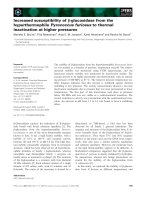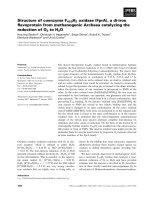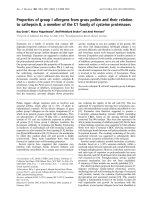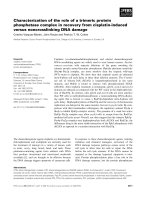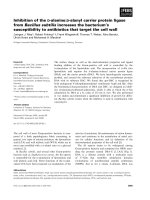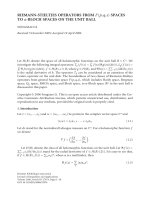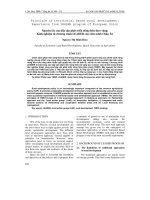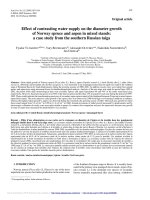Preventing the ends from justifying the means: Withholding results to address publication bias in peer-review
Bạn đang xem bản rút gọn của tài liệu. Xem và tải ngay bản đầy đủ của tài liệu tại đây (401.9 KB, 7 trang )
Button et al. BMC Psychology (2016) 4:59
DOI 10.1186/s40359-016-0167-7
EDITORIAL
Open Access
Preventing the ends from justifying the
means: withholding results to address
publication bias in peer-review
Katherine S. Button1*, Liz Bal2, Anna Clark2 and Tim Shipley2
Abstract
The evidence that many of the findings in the published literature may be unreliable is compelling. There is an
excess of positive results, often from studies with small sample sizes, or other methodological limitations, and the
conspicuous absence of null findings from studies of a similar quality. This distorts the evidence base, leading to
false conclusions and undermining scientific progress. Central to this problem is a peer-review system where the
decisions of authors, reviewers, and editors are more influenced by impressive results than they are by the validity
of the study design. To address this, BMC Psychology is launching a pilot to trial a new ‘results-free’ peer-review
process, whereby editors and reviewers are blinded to the study’s results, initially assessing manuscripts on the
scientific merits of the rationale and methods alone. The aim is to improve the reliability and quality of published
research, by focusing editorial decisions on the rigour of the methods, and preventing impressive ends justifying
poor means.
Keywords: Publication bias, Peer review, Results-free review, Transparency
Introduction
Psychology has received much criticism of late, with
classic findings failing to replicate, and high-profile cases
of scientific fraud [24, 45]. Psychology is not alone. The
evidence of unreliable findings across biomedical and social sciences is compelling [2, 15, 20, 36, 42]. There is a
surfeit of studies reporting significant positive results
(typically, p < 0.05), often from studies with small sample
sizes, or other methodological limitations, and a conspicuous absence of the corresponding null findings
from studies of a similar quality. This distorts the evidence
base, increasing the proportion of false positive findings,
and leading to biased estimates in meta-analyses.
Central to the problem is the peer-review system, and
the role it plays in perpetuating biases in the published
record; generally, authors, reviewers, and editors prefer
results which show support for tested hypotheses and
are prejudiced against submitting or publishing inconclusive or null findings. Rosenthal famously referred to this
as the file drawer problem [33]; statistically significant
* Correspondence:
1
Department of Psychology, University of Bath, Bath BA2 7AY, UK
Full list of author information is available at the end of the article
findings which support the alternative hypothesis are published, while those studies with inconclusive or negative results languish in the author’s file drawer, hidden from peer
and public awareness.
As will be discussed, there are many factors that bias
the decision-making of authors, reviewers and editors
throughout the publication process to the detriment of a
reliable evidence base. In the absence of external pressures, the simple human desire for seeking information
that supports one’s beliefs, and ignoring that which does
not [1, 26], means authors are more likely to find, and
reviewers to believe, evidence that confirms accepted
theories. There are also differences in interpretability of
positive and null findings (compounded by common design flaws such as having low statistical power) which
mean that positive results can be misguidedly seen to
overcome methodological weakness that would be critical for a null finding.
The bias for positive results is further exacerbated by
the external influence of a competitive research culture.
Publications are the prime currency for advancing academic careers [43], and where editorial decisions are seen
to favour positive results, researchers are encouraged to
© The Author(s). 2016 Open Access This article is distributed under the terms of the Creative Commons Attribution 4.0
International License ( which permits unrestricted use, distribution, and
reproduction in any medium, provided you give appropriate credit to the original author(s) and the source, provide a link to
the Creative Commons license, and indicate if changes were made. The Creative Commons Public Domain Dedication waiver
( applies to the data made available in this article, unless otherwise stated.
Button et al. BMC Psychology (2016) 4:59
adopt practices to boost their chances of finding positive
results [38]. These practices often increase the risk of findings being false positive or inflated estimates, and thus further undermine scientific progress [5]. However, in the
competition for publication, this risk is either ignored, or
accepted as a price worth paying.
In order to improve the quality and reliability of published research, the criteria determining publication
must be aligned with those for conducting rigorous scientific practice. The purpose of scientific enquiry is to
estimate the presence and size of causal associations,
and results from studies designed and conducted to the
highest standards of scientific rigour will provide the
most reliable and informative estimates. Thus, for the
optimal advancement of science it seems logical that decisions regarding what to publish would be better based
on judging quality, rather than results [11]. One way to
achieve this would be ‘results-free’ review, where results
are hidden from editors and reviewers, forcing reviewer
reports and editorial decisions to be based on the scientific rigour of the study design alone.
This month BMC Psychology launches a pilot to trial a
new ‘results-free’ peer-review process, to address the
problem of bias in the editorial process. Editors and reviewers will be blinded to the study’s results, and decide
whether to accept or reject manuscripts based on the
scientific merits of their rationale and methods alone.
There are multiple insidious ways in which the fixation
on positive results biases decision to the general detriment of science, and as outlined below, ‘results-free’ review has the potential to address many of them.
Page 2 of 7
and, in a similar analysis in 2010, over 92% of psychology/psychiatry papers were still found to claim support for their tested hypothesis [12], suggesting that the
degree of publication bias has remained high.
Basing decisions to publish on the nature of a study’s
results is wasteful. It distorts the evidence available for
policy makers and other key stakeholders, leading to
false conclusions which can have severe consequences.
In the biomedical literature, this can put patients at risk
if the published evidence falsely suggests that ineffectual
or harmful treatments work [17]. Selectively publishing
positive results also hinders the incremental progression
of science, and may explain the paucity of basic findings
translating into clinical applications [21, 31, 32]. Many a
PhD student has been demoralised to find they have
wasted a year or more of their training trying to replicate
and build on seemingly well-established findings only to
find out that many others have also tried and failed, but
their null findings were unpublished.
However, despite the undermining effects of publication bias on the evidence base, it persists for a variety of
reasons. At a relatively simple level, there are asymmetries in the dominant model of statistical inference which
mean that null findings are more difficult to interpret,
and more afflicted by the limitations of poor study design, than positive results. Thus authors are less inclined
to write them up and reviewers more inclined to reject.
At a systemic level, career pressures to publish offer a
sharp incentive to authors to favour writing up papers
with the greatest chance of success, and under the
current system of publication this will inevitably favour
positive results.
Publication bias
Publication bias is the term for what occurs whenever
the research findings in the published literature differ
systematically from the population of all studies completed in a given area [34]. Publication bias arises from
the decisions of investigators, reviewers, and editors to
submit or accept manuscripts for publication based on
certain study characteristics. This would be beneficial if
decisions were made solely on study quality [11]. However, publication decisions are most influenced by the
direction or strength of the study finding; strong results
clearly in favour of the study hypothesis are overrepresented, while studies reporting mixed or null findings
are underrepresented.
Psychologists provided some of the first empirical
evidence that the literature was biased towards positive
results [10, 18, 26, 37, 39–41]. In 1959, Sterling found
that of all the articles which used tests of significance
published in 4 journals, 97% found in favour of the alternative hypothesis. However, despite psychologists’
early awareness of the dangers of such a publication
bias, psychology has been relatively slow to intervene
The problem of interpreting null results
A major contributing factor to both reviewer and author
decisions to publish is the differences in interpretability
of positive and null findings. Despite its many documented problems, Null hypothesis significance testing
(NHST) remains the dominant framework for much
experimental psychological research. However, there
are asymmetries in the inferences one draws in this
approach that mean null results are more difficult to
interpret than positive ones. NHST is a hybrid of Fisher’s
concept of null hypothesis testing [14], and the NeymanPearson concepts of Type I (α) and Type II error (β) and
statistical power (1-β), but its application tends to lean
most on Fisher’s concept of null hypothesis testing ([44];
[7], in press).
The first asymmetry arises in the strength of inferential claim. Obtain a positive result (p < 0.05) and one can
boldly reject the null hypothesis and claim evidence of
an effect. However, obtain a null result, and one has simply failed to reject the null hypothesis; one cannot claim
evidence of no effect. The second and related asymmetry
Button et al. BMC Psychology (2016) 4:59
presents in the different weighting researchers give to
the risk of type I and II errors. Text-book research designs adopt a 5% Type I error rate (p < 0.05), while
accepting a higher Type II error rate of 20% (i.e., 80%
power). In practice, however, the asymmetry is even
greater - researchers ostensibly adhere to the 5% type
I rate but seem to pay little mind to statistical power,
and studies with power as low as 20% are common [5].
The impact this has on author and editorial decisions
is best illustrated with an example: Suppose a researcher
runs a series of studies with 20% statistical power (and
thus a type II error rate of 80%), and sets the significance
threshold at 5%. A null result is uninformative. The study
design is so poor (in terms of having insufficient statistical
power) that the researcher expects 80% of the studies to
miss genuine effects. As a null result is more likely than
not to be an (type II) error, the researcher decides it is not
worth writing up. If, on the other hand, the researcher
finds a result that passes the 5% significance threshold,
they might convince themselves (and the reviewers) that
despite the low power, the finding is worthy of publication
as the chance of it being an (type I) error is only 5%. While
in the case of a single study this decision making may
seem reasonable, it is clearly problematic when considered
across a population of studies.
The above example illustrates how the importance
attributed to methodological limitations, such as low
power, is highly influenced by the results. As methodological limitations tend to reduce a study’s sensitivity to detecting effects (via increasing standard errors), null results
are often seen as an expected consequence of poor design.
In contrast, finding a statistically significant result in a study
of similar quality is often interpreted as a success, because
the effect was found ‘despite the limitations’ of small sample
size, or measurement error. Indeed, passing the significance
threshold may be seen as indicative of how large, or robust
that effect must be [13]. Thus a third asymmetry arises in
study quality; design limitations are seen to weaken the case
for publishing a null result, while passing the 5% significance criterion can be seen as a golden ticket for dismissing
away methodological concerns.
Perhaps because of the differences in interpretation,
reviewers have been shown to be highly influenced by
the direction and strength of effects [11]. On average,
null papers take several months longer from the time of
submission to eventual publication than positive papers
(median, 1.1 vs 0.8 years; P = .04), suggesting that null
results receive more criticism during the peer-review
process [19]. This delay may stem from the increased
difficulties of trying to persuade reviewers of the merits
of null findings.
Reviewers have also been found to judge the methods
and quality of null studies more critically than those of
positive studies. Mahoney [26] randomly assigned referees
Page 3 of 7
to review 1 of 5 versions of a manuscript, all with identical
introduction and methods sections, but different results
and discussion sections (positive, negative, methods only,
mixed results with positive discussion, mixed results with
negative discussion) . The methods, data presentation, scientific contribution, and publication merit of manuscripts
with positive results were rated as being nearly twice as
high as manuscripts with negative results. Thus, negative
findings seem to disproportionally and detrimentally affect
appraisals of study quality and merit. This suggests that
any attempts to base editorial decisions on methodological
merit, are likely to be biased if the results are known.
Reviewers and editors act as the gatekeepers to publication, and may hinder the progress of null findings that
contradict their beliefs. Researchers can become welded
to certain theories or ideas, promoting the evidence that
supports the scientific dogma, while dismissing that
which does not. Examining sex bias in psychotherapy,
Smith [40] found that while the published literature supported the widely held notion that the standards clinicians’ hold regarding mental health are biased against
women, the unpublished data obtained from data requests was found to show the same degree of bias but in
the opposite direction. Similar to those reporting null results, studies with results that contradict the scientific
dogma may be less likely to be submitted or face more
hurdles to persuading reviewers that they are worthy of
publication.
Authors’ decisions and career pressures
Analysing a discrete population of conducted studies
(Time-Sharing Experiments in the Social Sciences, k = 221),
Franco and colleagues found that strong results were 60%
more likely to be written up, and 40% more likely to be
published, than null results [16]. When asked why they
choose not to write up their null findings, 15 out of the
26 authors who replied suggested it was in the belief
that null results have little publication potential. Based
on the asymmetries described above, the authors’ decisions not to pursue null papers seem reasonable given
the uphill struggle null papers face during the review
process.
Academics are under increasing career competition
and peer-reviewed publications, citations, and grant
funding are the prime currencies for advancing academic
research careers. Over the past 30 years, the number of
faculty positions in the US has remained relatively constant, but the number of PhDs awarded has increased
substantially [35]. The competition for faculty positions
is therefore fierce. Once secured, retaining a faculty
position can be dependent on meeting key performance
targets, and the main indicators of academic success
are number of publications, journal impact factors and
number of citations [43].
Button et al. BMC Psychology (2016) 4:59
As has been discussed, in the current publication system, positive results are more easily published, especially
those studies reporting large effects which, despite methodological limitations, are often published in highimpact journals. Indeed, meta-analyses have found that
the degree of inflation in positive results correlates to
the impact factor of the publishing journal, with highly
biased results from small studies published in some of
the highest impact journals [27]. In addition to being
easier to publish in higher impact journals, positive results are also more likely to be cited once published,
thus further increasing the incentives for authors to find
them [25].
All of this combines to create a powerful incentive
structure for authors to find certain results, and powerful
incentives lead to biased decision making. For example,
pharmaceutical companies have received much criticism
for prioritising the publication of trials showing drugs to
be highly effective, while delaying or suppressing the publication of data suggesting more modest effects [3, 17].
While financial incentives are an obvious source of bias in
pharma, academics operating in such a competitive career
culture may be equally at risk of bias. Indeed, the evidence
produced in competitive research environments may be
particularly unreliable, with the proportion of studies
reporting positive results increasing with increased competition in US research institutions [12].
This pressure to publish in a publication system that
favours positive results undermines scientific integrity,
both by dissuading authors from publishing null findings, but also by incentivising researchers to adopt questionable research practices to maximise their chances of
finding something positive, and thus more publishable,
in each data set [12]. Flexible analytical procedures [38],
especially in low-powered studies, can generate a large
number of positive results, although most will either be
false positive or inflated [5]. Researchers may incorrectly
write these analyses up as if they were confirmatory
tests, retro-fitting a new hypothesis to explain a chance
result [22].
There are numerous ‘questionable research practices’
which authors can use to exploit the multiple decision
points during data collection and analysis to generate
positive results [22]. These include the removal of an
outlier, transforming a variable, collecting more data,
switching outcome variables, adding or removing covariates, until one happens upon a significant result [38].
Researchers may then forget about the unsuccessful
paths, and write-up only those which yielded statistically
significant results [29]. There is good evidence that such
undisclosed flexibility in analysis is common practice. In
a survey of 2000 psychologists, over half admitted to
having failed to report all dependent measures, and selectively reporting studies that “worked”, with the estimated
Page 4 of 7
actual prevalence of these behaviours (using admission estimates) rising to nearly 100% [22].
Undisclosed analytical flexibility is a particularly insidious form of bias, as it resonates so deeply with the natural
human desire for seeking and embellishing information
that supports one’s beliefs and ignoring or discrediting
that which does not [1, 26]. This, combined with the unintuitive nature of statistical inference, means that many a
selective reporting error may be made in ignorance [4, 30].
However, the easier path to publication for manuscripts
reporting strong, positive, consistent results, creates a
strong incentive for researchers to find and selectively report such results. Therefore, while editorial decisions during peer review remain influenced by the nature of a
study’s results, publication bias will persist as researcher
behaviour will adapt accordingly.
Initiatives to reduce publication bias and increase
transparency
To reliably inform treatment decisions, social policies,
or the design of the next incremental empirical study,
the published literature must include all available data
that is of acceptable quality [11]. While psychology and
social sciences may have led the way in demonstrating
and describing publication bias, medicine and, in particular, the systematic review and clinical trials movement, has since led the avocation and implementation of
scientific practices to mitigate its effects. These include
public repositories for the mandatory registration of trial
protocols (e.g., ClinicalTrials.gov and ISRCTN), comprehensive guidelines for transparent reporting of procedures and results (the EQUATOR network), and the
publication of study protocols.
Pre-registration
Registration of clinical trial protocols before data collection commences is now mandatory, making it possible
to trace trials from inception to completion. In the UK,
the National Institute for Health Research has gone a
step further and made publication of results, in addition
to protocol pre-registration, a legal obligation for all
studies that they fund. However, although this ensures
that the publication record is virtually complete, and
that risk of bias in results from questionable research
practices is reduced, the direction or strength of results
may still bias reviewer and editorial decisions, such that,
holding quality constant, null findings might end up in
lower impact journals [27, 28], or may take longer to be
submitted for publication at all [3].
Pre-registration of study protocols is a powerful tool
against some forms of publications bias. The protocol
repository provides an audit trail for studies, recording
what should be present in a complete publication record
and thus opening the file drawer. The inclusion of detailed
Button et al. BMC Psychology (2016) 4:59
Solutions
Page 5 of 7
Button et al. BMC Psychology (2016) 4:59
check for adherence to methods and to allow minor
revisions.
This simple approach offers an eloquent solution to
many of the key drivers of publication bias discussed
above, and a recent pilot in a politics journal of a similar
process [13] indicates that ‘results-free’ reviews are feasible, and acceptable to authors and reviewers, though
the numbers were relatively small. ‘Results-free’ review
should tackle bias that occurs during the actual review
process, by preventing reviewer judgments of study
quality being biased against studies with null results. It
also incentivises authors to write up high-quality studies
with null results, and might dissuade them from submitting low-quality studies with dubious positive results.
Knowing that the reviewers will be focussing on the rationale and methods might also improve the quality and
transparency of methods reporting. Thus, ‘results-free’
review has the potential to increase the transparency of
methods reporting, improve the scientific quality of published research, and increase in the overall reliability of
results.
Evaluating the effectiveness of proposed solutions
There has been a proliferation in new publishing initiatives designed to reduce publication bias, and while this
is laudable, it is important that these initiatives are systematically and rigorously evaluated to ensure they are
having the desired outcomes. BMC Psychology is taking
the bold step to conduct a randomised controlled trial to
evaluate their ‘results-free’ peer-review process. In the
first instance, a single arm pilot will assess the feasibility
of ‘results-free’ review and optimise the process. Following this we plan to conduct a full randomized controlled
trial to assess the effects of results-free review on publication bias and the editorial decision-making process,
and collating author, editor, and reviewer feedback. If
deemed feasible and effective, it is our hope that we may
roll out results-free review (with any revisions) across
other BioMed Central journals. We have designed the
process to be as simple as possible, as an alternative
model that can be integrated as part of the traditional
review process, or more radically, to replace traditional
post-study review if the evidence shows it to be superior.
We welcome comments and feedback on the process as
the trial progresses.
Concluding remarks
Addressing a problem as thorny as the wider reproducibility crisis will require multiple interventions to resolve,
but a central philosophy must be the re-alignment of incentives for career progression with those for conducting
high quality rigorous research. Scientist should be encouraged to conduct and publish science of the highest
scientific rigour and integrity, and this will only be achieved
Page 6 of 7
if editorial decisions are based on the methodological
quality of the research rather than its outcomes. The
results-free review model, launched this month in BMC
Psychology, offers a solution by focusing editorial decisions on the scientific rigour of the study design, and
preventing editorial decisions being unduly biased by
study findings. The human powers of self-persuasion
and post-hoc justification mean that withholding results
from peer-reviewers may be the only reliable way to protect reviewers and editors against the often unconscious
influence of the results justifying the means.
Acknowledgements
We thankfully acknowledge the useful feedback on the implementation of
this results-free peer-review trial from the BMC Psychology Editorial Board and
the Research Integrity group ( especially Maria Kowalczuk. We also thankfully
acknowledge members of the Editorial Office, who have helped with the
implementation as part of the peer-review workflow for BMC Psychology,
especially Ruth Baker and Sanam Sadarangani.
Funding
Not applicable.
Availability of data and materials
Not applicable.
Authors’ contributions
KB wrote the first draft and AC, TS and LB contributed additional edits to the
text and comments. All authors read and approved the final manuscript.
Core members of the Working Group responsible for the implementation
of this results-free peer-review trial include KB, AC, TS and LB. All group
members have contributed equally to this project.
Competing interests
AC, TS and LB are employees of BioMed Central. KSB declares no competing
interests.
Consent to publish
Not applicable.
Ethics approval and consent to participate
Not applicable.
Author details
1
Department of Psychology, University of Bath, Bath BA2 7AY, UK. 2BioMed
Central, London, UK.
Received: 15 November 2016 Accepted: 15 November 2016
References
1. Beck AT. Cognitive therapy and the emotional disorders. New York:
International Universities Press; 1976.
2. Begley CG, Ellis LM. Drug development: Raise standards for preclinical
cancer research. Nature. 2012;483:531–3.
3. Bourgeois FT, Murthy S, Mandl KD. Outcome reporting among drug trials
registered in ClinicalTrials.gov. Ann Intern Med. 2010;153:158–66.
4. Button KS. Statistical Rigor and the Perils of Chance. eNeuro. 2016;3(4). doi:
10.1523/ENEURO.0030-16.2016.
5. Button KS, Ioannidis JP, Mokrysz C, et al. Power failure: why small sample
size undermines the reliability of neuroscience. Nat Rev Neurosci.
2013;14:365–76.
6. Button KS, Lawrence NS, Chambers CD, et al. Instilling scientific rigour at the
grassroots. Psychol. 2016;29:158–67.
7. Button KS and Munafò MR. Powering Reproducible Research. In: Lilienfeld
SO and Waldman ID (eds) Psychological science under scrutiny: Recent
challenges and proposed solutions. New York: Wiley & Sons. (in press).
Button et al. BMC Psychology (2016) 4:59
8.
9.
10.
11.
12.
13.
14.
15.
16.
17.
18.
19.
20.
21.
22.
23.
24.
25.
26.
27.
28.
29.
30.
31.
32.
33.
34.
35.
36.
37.
38.
39.
40.
41.
Chambers CD. Registered reports: a new publishing initiative at Cortex.
Cortex. 2013;49:609–10.
Chambers CD, Dienes Z, McIntosh RD, et al. Registered reports: realigning
incentives in scientific publishing. Cortex. 2015;66:A1–2.
Coursol A, Wagner EE. Effect of positive findings on submission and acceptance:
A note of meta-analysis bias. Prof Psychol Res Parctice. 1986;17:136–7.
Dickersin K. The existence of publication bias and risk factors for its
occurrence. JAMA. 1990;263:1385–9.
Fanelli D. Do pressures to publish increase scientists' bias? An empirical
support from US States Data. PLoS ONE. 2010;5:e10271.
Findley MG, Jensen NM, Malesky EJ, Pepinsky TB. Can results-free review
reduce publication bias? The results and implications of a pilot study.
Comparative Political Studies. 2016;49(13):1667–1703.
Fisher R. Statistical methods and scientific induction. J Royal Stat Soc Series
B-Stat Methodol. 1955;17:69–78.
Francis G. Publication bias and the failure of replication in experimental
psychology. Psychon Bull Rev. 2012;19:975–91.
Franco A, Malhotra N, Simonovits G. Social science. Publication bias in the
social sciences: unlocking the file drawer. Science. 2014;345:1502–5.
Goldacre B. Bad pharma : how drug companies mislead doctors and harm
patients. London: Fourth Estate; 2012.
Greenwald AG. Consequences of prejudice against the null hyptohesis.
Psychol Bull. 1975;82:1–20.
Ioannidis, JP. Effect of the statistical significance of results on the time to
completion and publication of randomized efficacy trials. JAMA. 1998;279:
281–6.
Ioannidis JP. Why most published research findings are false. PLoS Med.
2005;2:e124.
Ioannidis JPA. Why Science Is Not Necessarily Self-Correcting. Perspect
Psychol Sci. 2012;7:645–54.
John LK, Loewenstein G, Prelec D. Measuring the Prevalence of
Questionable Research Practices With Incentives for Truth Telling. Psychol
Sci. 2012;23:524–32.
Kenall A, Edmunds S, Goodman L, et al. Better reporting for better research:
a checklist for reproducibility. BMC Neurosci. 2015;16:44.
Laws KR. Psychology, replication & beyond. BMC Psychol. 2016;4:30.
Leimu R, Koricheva J. What determines the citation frequency of ecological
papers? Trends Ecol Evol. 2005;20:28–32.
Mahoney MJ. Publication prejudices: An experimental study of confirmatory
bias in the peer review system. Cognit Ther Res. 1977;1:161–75.
Munafo MR, Stothart G, Flint J. Bias in genetic association studies and
impact factor. Mol Psychiatry. 2009;14:119–20.
Murtaugh PA. Journal qulaity, effect size, and publication bias in metaanalysis. Ecology. 2002;83:1162–6.
Neuroskeptic. The Nine Circles of Scientific Hell. Perspect Psychol Sci. 2012;7:643–4.
Nuzzo R. Fooling ourselves. Nature. 2015;S26:182–5.
Perel P, Roberts I, Sena E, et al. Comparison of treatment effects between
animal experiments and clinical trials: systematic review. BMJ. 2007;334:197.
Prinz F, Schlange T, Asadullah K. Believe it or not: how much can we rely on
published data on potential drug targets? Nat Rev Drug Discov. 2011;10:712.
Rosenthal R. The File Drawer Problem and Tolerance for Null Results.
Psychol Bull. 1979;86:638–641.
Rothstein H, Sutton AJ, Borenstein M. Publication bias in meta-analysis:
prevention, assessment and adjustments. John Wiley: Chichester. 2005.
Schillebeeckx M, Maricque B, Lewis C. The missing piece to changing the
university culture. Nat Biotechnol. 2013;31:938–41.
Scott S, Kranz JE, Cole J, et al. Design, power, and interpretation of studies
in the standard murine model of ALS. Amyotroph Lateral Scler. 2008;9:4–15.
Shadish Jr WR, Doherty M, Montgomery LM. How many studies are in the
file drawer? an estimate from the family/marital psychotherapy literature.
Clin Psychol Rev. 1989;9:589–603.
Simmons JP, Nelson LD, Simonsohn U. False-positive psychology:
undisclosed flexibility in data collection and analysis allows presenting
anything as significant. Psychol Sci. 2011;22:1359–66.
Smart RG. The importance of negative results in psychological research.
Canadian Psychol. 1964;5:225–32.
Smith ML. Sex bias in counseling and psychotherapy. Psychol Bull.
1980;87:392–407.
Sterling TD. Publication decisions and their possible effects on inferences
drawn from tests of significance–or vice versa. J Am Stat Assoc. 1959;54:30–4.
Page 7 of 7
42. Steward O, Popovich PG, Dietrich WD, et al. Replication and reproducibility
in spinal cord injury research. Exp Neurol. 2012;233:597–605.
43. van Dijk D, Manor O, Carey LB. Publication metrics and success on the
academic job market. Curr Biol. 2014;24:R516–7.
44. Vankov I, Bowers J, Munafo MR. On the persistence of low power in
psychological science. Q J Exp Psychol (Hove). 2014;67:1037–40.
45. Yong E. Replication studies: Bad copy. Nature. 2012;485:298–300.
Submit your next manuscript to BioMed Central
and we will help you at every step:
• We accept pre-submission inquiries
• Our selector tool helps you to find the most relevant journal
• We provide round the clock customer support
• Convenient online submission
• Thorough peer review
• Inclusion in PubMed and all major indexing services
• Maximum visibility for your research
Submit your manuscript at
www.biomedcentral.com/submit
